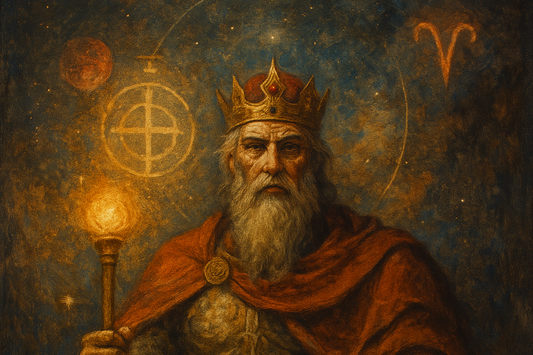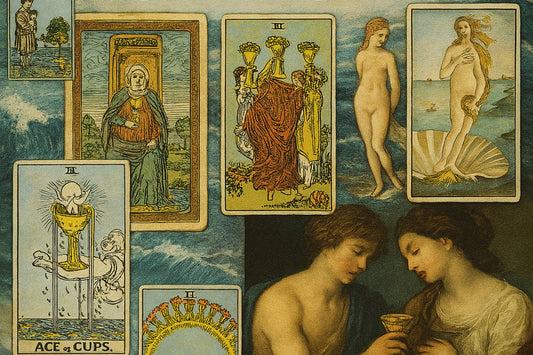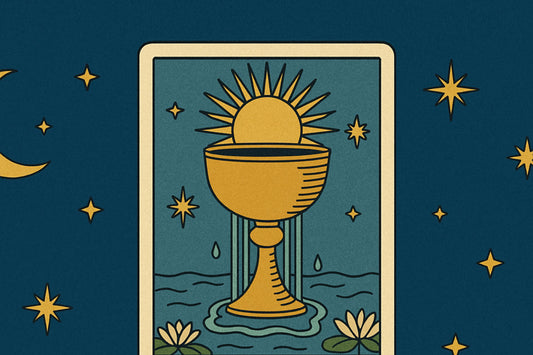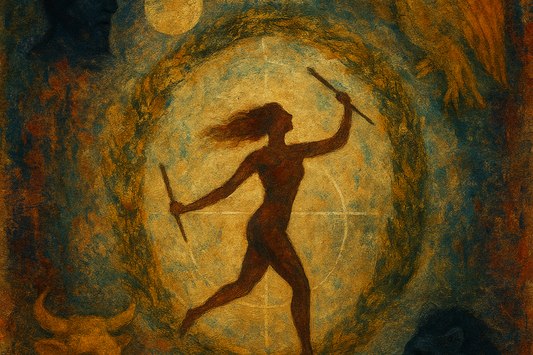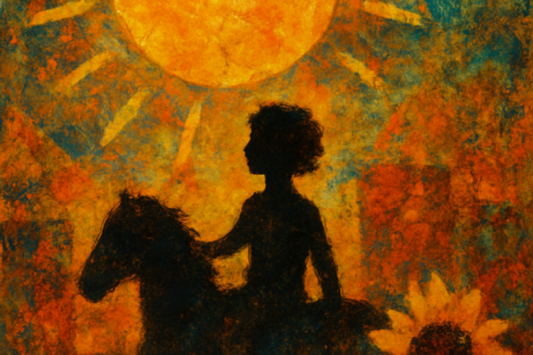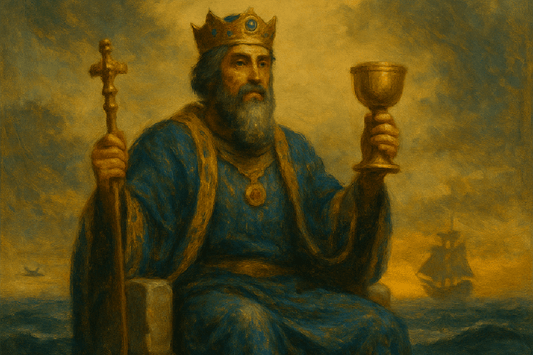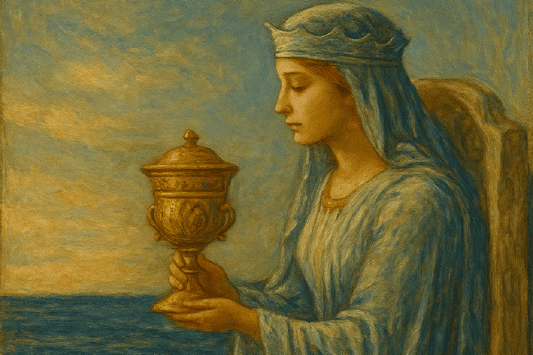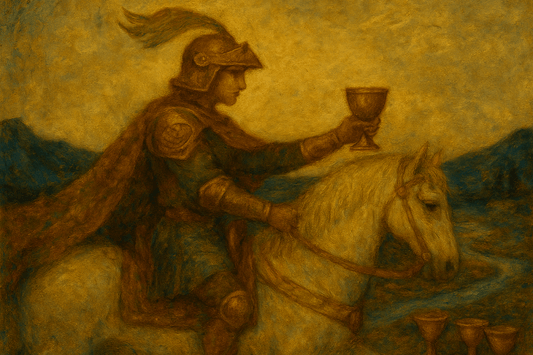The Hanged Man in Tarot: Surrender, Stillness and Letting Go
Tarot AccessoriesTable of Contents
- TL;DR: The Hanged Man Quick Reference
- The Archetype of The Hanged Man in the Tarot
- Symbolism and Imagery of The Hanged Man
- Meaning of The Hanged Man in a Tarot Reading
- Reversed Meaning of The Hanged Man in a Tarot Reading
- The Evolution of The Hanged Man Throughout History
- Numerology and the Number Twelve in Tarot
- Astrological Resonance of The Hanged Man
- FAQs About The Hanged Man in Tarot

TL;DR: The Hanged Man Quick Reference
Upright: Suspension, surrender, letting go, perspective shift, pause, spiritual inversion, initiation, altered state, divine waiting, non-action
Reversed: Stagnation, avoidance of surrender, resistance to change, martyrdom, delay, indecision, spiritual bypassing, unwillingness to let go
The Archetype of The Hanged Man in the Tarot
The Hanged Man doesn’t struggle. He chooses to hang.
This card is not about defeat - it’s about surrender. The archetype here is that of voluntary inversion: the seeker who pauses, flips their perspective, and chooses stillness over striving. This is not passive. It’s profoundly active.
In the arc of The Fool’s journey, The Hanged Man is a threshold. You can’t push through it - you have to let go. The Hanged Man is the archetype of liminal space, spiritual waiting, and the death of ego through sacrifice.
Our famous Hanged Man hangs upside down not because he’s stuck - I mean, how boring would that be! - but because truth lives on the other side of what we think we already know.
Related Cards to Explore
Strength in Tarot: Inner Power, Sacred Patience and the Courage to Soften
The Hermit in Tarot: Solitude, Wisdom and the Light Within
Wheel of Fortune in Tarot: Fate, Turning Points and the Cycles of Becoming
Justice in Tarot: Truth, Balance and the Sword of Inner Law
Symbolism and Imagery of The Hanged Man
In the Rider-Waite-Smith deck, The Hanged Man hangs by one foot from a T-shaped cross (or Tau cross), often depicted as a living tree. His hands are behind his back, his face serene, his free leg bent into a triangle.
The entire posture echoes and expresses the number 4 (stability) and 3 (divine expression) - a symbol of harmony within suspension.
A glowing halo (an aureole) surrounds his head: he is not being punished - he is being illuminated. This is not torture. This is initiation.
He wears red leggings (will) and a blue tunic (receptivity), echoing the blend of active and passive principles. Everything in this image says: “stop resisting.”
Meaning of The Hanged Man in a Tarot Reading
When The Hanged Man appears in your tarot reading, it signals a moment where you must pause, surrender, and release control. It’s not about pushing through - it’s about yielding to what is.
It often indicates:
- Waiting for clarity
- Releasing expectations
- Choosing stillness over action
- Allowing old perspectives to die
When you pull The Hanged Man, he's asking you:
What if you stopped trying to solve this? What would happen if you just... let go?
He's inviting you into the mystery of non-doing. Which isn't passivity - it's sacred receptivity.
Reversed Meaning of The Hanged Man in a Tarot Reading
Reversed, The Hanged Man suggests resistance to surrender. You may be clinging to control, trying to force a resolution, or avoiding a necessary pause.
This can show up as:
- Impatience with the process
- Stalling instead of surrendering
- Playing the martyr
- Staying stuck because you fear what letting go might reveal
Reversed, the card says: you’re hanging on - but not to wisdom. You’re hanging on to the illusion that you can control what life is asking you to surrender.
The Evolution of The Hanged Man Throughout History
Origins of the Archetype

Historically, the image of a man hanging upside down was associated with traitors (pittura infamante: the ultimate weapon of shame) - particularly in medieval Italy, where being suspended by one foot was a punishment for betrayal. But over time, the image took on more spiritual dimensions - echoing myths of sacrifice, initiation, and inversion.
Think: Odin hanging from the World Tree for nine days to gain wisdom. Or Christ suspended between worlds on the cross. The archetype is old: to gain wisdom, something must die - even if it’s just your old perspective.
Early Tarot Appearances - Il Traditore
In the Visconti-Sforza and other early decks, this card was titled Il Traditore (The Traitor). But the image was already ambiguous - the hanging figure did not appear distressed. The implication was that betrayal was a social judgment - but perhaps the figure knew something the crowd didn’t.

It was a card of outsider consciousness - of someone punished for being different, but who might actually be ahead of their time.
Marseille Tarot - Calm in Suspension
In the Marseille deck, the image becomes more codified: a man hanging from a wooden beam, one leg bent to form an inverted 4, often with coins falling from his pockets.
The spiritual meaning deepens - this is no longer a traitor, but a figure of voluntary sacrifice. Someone willing to give something up - even reputation or material wealth - to see what others can’t.
The stillness becomes sacred. The inversion becomes insight.

French Occult Tradition - Oswald Wirth and the Path of Mystical Surrender
The French Occultist and tarot maker Oswald Wirth reframed The Hanged Man in his tarot deck as initiation through paradox - the stage where the seeker voluntarily pauses to allow the soul to reorient.
In his writings, The Hanged Man is the point in the journey where inner truth begins to outweigh social norms. Wirth did not see him as a traitor, but as a mystic in transformation.
The French Occultists viewed this card as a break from linear time - a necessary crucible for spiritual unfoldment.
Golden Dawn - Suspension Between Geburah and Hod

The Golden Dawn assigned The Hanged Man to Water - fluidity, receptivity, dissolution. On the Tree of Life, it corresponds to Path 23 - The Path of Mem - between Geburah (severity) and Hod (intellect) on the Kabbalistic Tree of Life.
This path represents the sacrifice of rational will to access deeper truths. It is the surrender of egoic control - not in weakness, but in strength.
Aleister Crowley linked this card to redemption through submission. To him, The Hanged Man was the alchemical dissolution required before rebirth.
Rider-Waite-Smith - The Stillpoint of Initiation
Pamela Colman Smith’s illustration sealed the modern iconography: the calm, glowing, inverted figure. No shame. No struggle. Only stillness and light.

Waite described this card as “the card of the Great Work” - the sacrifice required for wisdom, the sacred pause before revelation.
In this deck, The Hanged Man became the threshold guardian - the one who stops so that something greater can move through.
Modern Decks - Trauma, Integration, and the Wisdom of Stillness
In contemporary decks, The Hanged Man often reflects healing, neurodivergence, non-linearity, or spiritual surrender.
He’s been reimagined as androgynous, feminine, shadowed, cosmic - but always hanging in stillness. Always letting go.
Modern interpretations focus less on loss and more on reorientation. He doesn’t fall - he floats. And in floating, he changes everything.
Numerology and the Number Twelve in Tarot
Twelve is a divine, foundational and transitional number - the end of a cycle (1+2 = 3) and the full grouping of the holy trinity. It echoes the zodiac, the apostles, the hours of the clock. It is symbolic of cosmic order before reversal.
In The Hanged Man, 12 becomes the pause before death (XIII). It’s not yet surrender - but the willingness to surrender.
It marks a moment where the ego doesn’t die… but loosens its grip.
Astrological Resonance of The Hanged Man
The Hanged Man is aligned with the element of Water - emotionally fluid, receptive, and initiatory. While there’s no fixed planetary ruler, he often resonates with Neptune - the planet of dreams, dissolution, mysticism, and sacrifice.
Neptune dissolves boundaries. It teaches by blurring, softening, and merging - and in The Hanged Man, we see the invitation to release all certainty and float.
It’s not about escape - it’s about transformation through release.
FAQs About The Hanged Man in Tarot
What does The Hanged Man mean in a love reading?
In love, The Hanged Man often suggests pause, perspective shift, or spiritual processing. It can indicate a need to release control, let go of expectations, or see the relationship from a new angle. It’s not an ending - but it is a reorientation.
Is The Hanged Man a yes or no card?
Neither. The Hanged Man is a wait card. It says: pause. Reflect. Surrender the need to act. Only then will clarity return.
What does The Hanged Man mean when reversed?
Reversed, this card signals resistance. You may be avoiding a necessary sacrifice, clinging to a stale identity, or refusing to surrender. It can also suggest that you’re stuck - but unwilling to explore why.
What archetype does The Hanged Man represent?
The Seer. The Initiate. The Mystic in the Void. The Hanged Man represents the archetype of Sacred Surrender - the wisdom that only emerges when you stop demanding answers and start listening to the silence.


